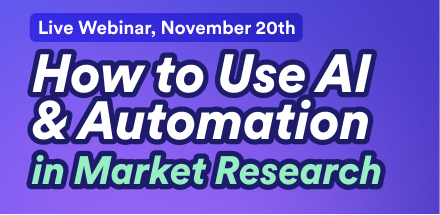Oh, text data - you love what it can tell you, but if I had to guess - you do not like analyzing it.
In a state of information overload, people are communicating digitally more than ever, whether through tweets, reviews, or open-ended responses to surveys. The data within those messages is an untapped gold mine of thoughts and opinions that companies can turn into insights.
The good: you’re able to get down to the nitty-gritty on how someone really feels about a product, brand, topic to improve their overall experience.
The bad: you’re most likely outsourcing your text data to another company. Or you are manually coding the lines of text yourself, so it’s not exactly a walk in the park.
The rise of AI text analysis
Text analytics involves analyzing large amounts of text to find insights. The rise of artificial intelligence has meant much of this process can now be automated, allowing humans to spend less time manually reading and coding text and more time finding valuable conclusions.
AI text analytics relies on various technological components to be effective, with Natural language processing (NLP) being one of the most crucial. NLP is a subfield of artificial intelligence (AI) that applies machine learning techniques to help computers understand and interpret human language. In the context of text analytics, NLP is vital for processing and organizing unstructured text data, making it ready for further analysis. This functionality allows market researchers to handle and analyze vast amounts of text data with greater accuracy.
Another key technology is machine learning (ML), which also falls under the AI umbrella and powers text analytics through algorithmic models. These models, once trained on labeled data, can identify patterns and make predictions, such as detecting sentiment or extracting relevant entities. This capability is what allows text analytics to scale and efficiently manage large quantities of unstructured text, leading to more accurate and insightful data analysis.
How market researchers can use text analysis
Text analytics provides significant opportunities for market researchers to uncover valuable insights and add value for their clients. Common applications of text analysis in market research include:
- Categorizing and extracting main themes from focus group discussions
- Analyzing online brand messaging and assessing competitor popularity
- Conducting whitespace analysis by examining product reviews
- Recognizing regional variations in customer perceptions of a brand or product
- Identifying emerging trends in the market
A lot of these use cases leverage publicly available data, like social media content and online reviews. As such, text analysis serves as an ideal tool for market researchers looking to gain actionable insights.
Ready to analyze your text?
Start a free trial of Displayr.
Displayr Text Analytics
Displayr is an all-in-one survey analysis and reporting tool with built-in Text Analysis.
Displayr's Text Analysis features allow users to:
- Automatically code unstructured verbatim text data
- Automatically code structured text data (e.g. spontaneous awareness brand lists)
- Code in a semi-automatic way blending your judgment with machine learning.
- Create a word cloud
- Analyze sentiments
- Use specific prompts for AI-generated results
Eliminate the need for multiple tools that are both time-consuming and even expensive. Save time with an improved process with one tool for all your survey analysis and reporting needs. Even automatically update reports with new data so there is no need to start over from the beginning – simply put the data in to get the story out.
Transform your text data into actionable insights with Displayr’s AI-powered text analysis.

